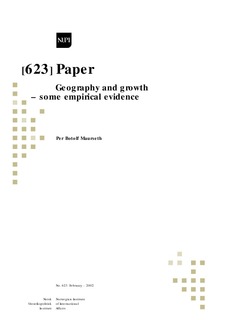| dc.contributor.author | Maurseth, Per Botolf | |
| dc.date.accessioned | 2016-06-24T14:15:59Z | |
| dc.date.accessioned | 2016-06-29T10:05:49Z | |
| dc.date.available | 2016-06-24T14:15:59Z | |
| dc.date.available | 2016-06-29T10:05:49Z | |
| dc.date.issued | 2002 | |
| dc.identifier.citation | Working Paper, NUPI nr 623. NUPI, 2002 | nb_NO |
| dc.identifier.issn | 0800 - 0018 | |
| dc.identifier.uri | http://hdl.handle.net/11250/2394561 | |
| dc.description | - | nb_NO |
| dc.description.abstract | Income in the world does not distribute randomly in space. There are geographic clusters of rich and poor countries. Also growth rates tend to be spatially clustered. Spatial regression analyses indicate that geographical clustering may be an inherent ingredient in growth mechanisms: Growth in one country stimulates growth in surrounding countries. A simple exogenous growth model with technology diffusion through trade in capital goods can account for some, but not all of these empirical patterns of growth and income distribution. | nb_NO |
| dc.language.iso | eng | nb_NO |
| dc.relation.ispartofseries | NUPI Working Paper;623 | |
| dc.rights | Navngivelse-Ikkekommersiell-DelPåSammeVilkår 3.0 Norge | * |
| dc.rights.uri | http://creativecommons.org/licenses/by-nc-sa/3.0/no/ | * |
| dc.title | Geography and growth - some empirical evidence | nb_NO |
| dc.type | Working paper | nb_NO |
| dc.date.updated | 2016-06-24T14:15:59Z | |
| dc.source.pagenumber | 29 p. | nb_NO |
| dc.identifier.cristin | 1364124 | |
| dc.subject.keyword | Internasjonal økonomi / International economics | |

